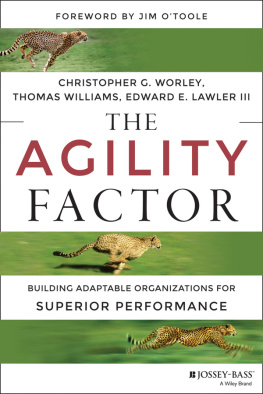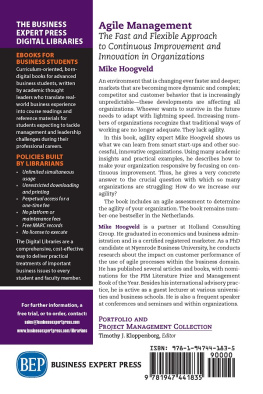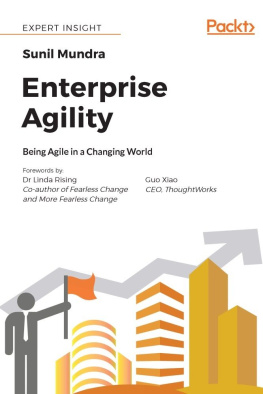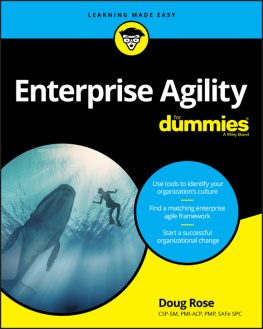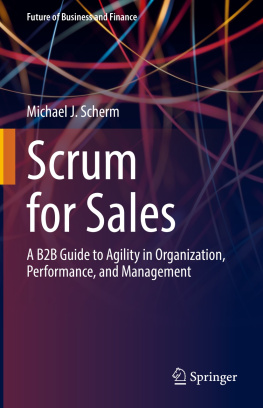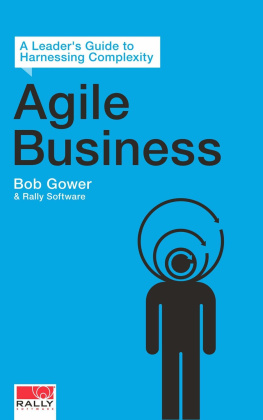You will find more material for your use on our website, www.syngineering.solutions , including:
Glossary of Terms: While we have tried to write in plain English the field of organizational design has numerous specialized terms. We define these as they are introduced and offer a brief overview at the start of . Still, its nice to have a glossary. To keep it current and to avoid adding pages to the book, we have placed it on the website.
References and Links: In the dedication and text, we mention only a very few of those who have provided us their wisdom, guidance, and counsel. We have devoted a section of the website to a more extensive list of references, including links to their websites with their latest thinking.
While we three authors, Rich, Monique, and Bill, come from different traditions and experiences, we each empathize with organizational leaders frustrated by the issues facing todays businesses. We have come to understand that organizational performance is a direct result of how well its constituent components drive and reinforce each other. Every organization is perfectly designed to get the results that it does. Those frustrated with the results must change the components.

Thats what Syngineering does and why we wrote the book, to support leaders of all types and levels in effectively and sustainably making these changes. To do so, we have sat at the feet of the gurus, synthesized and integrated their various disciplines, and added several things of our own. It was a joint product with equal contributions, so we struggled with order of authors. In the end, we decided that Richs visibility at international conferences and training programs positioned him well to be first in our authorship circle.
We have learned that its not about the best or latest models but about what works. Most often this means listening to the wisdom already present in the organization and finding ways to make it visible. But we have learned that there are powerful blockers in these systems, which even the most sophisticated data analytics rarely address. The complete picture emerges only through the myriad relationships in day-to-day operations. Some disparage this as office politics but for us it is the underlying reality of how work gets done. Understanding this rich tapestry enables our clients to see the blockers hampering their performance and to act to correct them.
We are pleased to offer you these approaches, ones that we have found to be effective. Its a roadmap, but does not include detailed driving directions. You will need to place your own organization and its challenges on the map, determine where youre headed, and chart your own course. Our hope is that having a detailed map of the terrain will make this effort much easier. All the best in your endeavors!
Rich Thayer for years supported global organization design efforts for Royal Dutch Shell. His specialty is helping organizations and individuals discern and satisfy their development needs. Rich uses a whole system view with data-driven analysis to get behind symptoms to underlying causes. This often involves culture and behavior changes to create the needed engagement, psychological safety, and honesty. Addressing root causes better aligns operations with strategy and yields superior performance. To sustain these results, Rich helps clients develop their own internal capabilities.
Richs early research and technical career showed him the vital role of technology and provided tools for understanding complex landscapes. Work process re-engineering led him into organization consulting at Shells global headquarters where he worked on major change efforts like the Sakhalin II mega-project, Gulf of Mexico producing operations, the North Caspian Operating Company, Shells enterprise-first behaviors initiative, and several joint science symposia. In 2010 Rich joined Bill and Monique in setting up what is now Syngineering Solutions. He now lives in Baltimore, Maryland where he serves on the boards of several local non-profits and facilitates programs to teach alternatives to violence in detention and corrections institutions.
Monique Carnino has over 20 years of experience working with leadership, teams and individuals in industries as diverse as energy, finance, IT, aviation, and security to create, communicate and carry out their strategies. Monique has led multiple cross-organization strategic transformational change programs where she focused on bringing about changes in the way people work, think and behave to achieve targeted outcomes. Throughout her studies and career, she has lived in eight countries on four continents and traveled extensively to over 65 countries. She has a masters degree in Business and multiple professional certifications.
After leaving a long-time career as an Organizational Development and Change Management Consultant with Shell, she set up her own consultancy business in South Africa. Here she consulted with large organizations in other industries and government on organizational design and development, and then joined forces with Bill and Rich. After seven years in Johannesburg, Monique returned to Houston, first with Shell and then with Chevron as an external change management lead on multiple agile change programs since 2017. She is a full-time working mother who enjoys going beyond boundaries as she collaborates with others to explore, learn and grow.
Bill Zybach has a long history of supporting organizational change in government and the public sector. During the Bill Clinton Administration he worked on reinventing government, which led to a balanced federal budget and increased public confidence in government. He helped build state-level agencies in Washington DC to support its ongoing statehood drive, and helped bring organization design principles to the government, business and not-for profits in South Africa. He has deployed agile approaches in manufacturing in France, in government in Washington DC, and in banking in the United States and in South Africa.
Bill is certified as an automotive mechanic, rodeo chute coordinator, yoga instructor, and Holacracy practitioner. He has completed 5 years of post-graduate work at the Gestalt Institute of Cleveland with certificates in organizational systems, executive coaching and group practice. Bill was on the board of the Organization Design Forum for nine years and is a member of the European Organization Design forum. He lives in and works virtually from his home on Senior Creek in Mollusk, Virginia.
This book was made possible by our numerous global collaborators:
Jay Galbraith and Amy Kates helped us to see organizations as systems with components that control both the work and the culture. Dick and Emily Axelrod gave us their conference model of change and canoe approach to effective meetings. Stu Winby and Jay Galbraith showed us how creativity and accountability can facilitate the design process using prototyping, design thinking, and rapid deployment.
Brian Robertsons Holacracy and Diana Larsens leadership in the Agile Alliance have spread Agile with a capital A around the world as a new form of operating model, not just an adaptation of the software development method. Noted author Naomi Stanford, in collaboration with Stu Wigham, brought continuous design and agility into the public sector. Chris Worleys research and teaching made us aware of what is emerging as agile organization design. Finally, Sally Parker and Argie Vasilakes, in comparing natural systems and organization design, inspired us to more overtly incorporate Gestalt principles.


